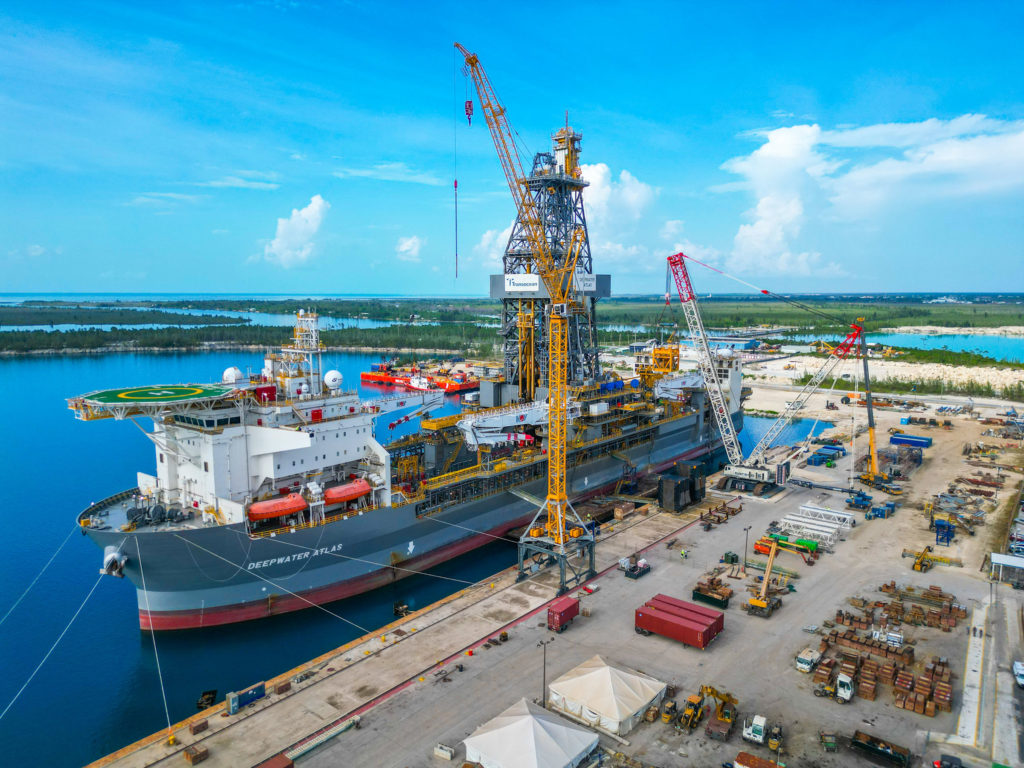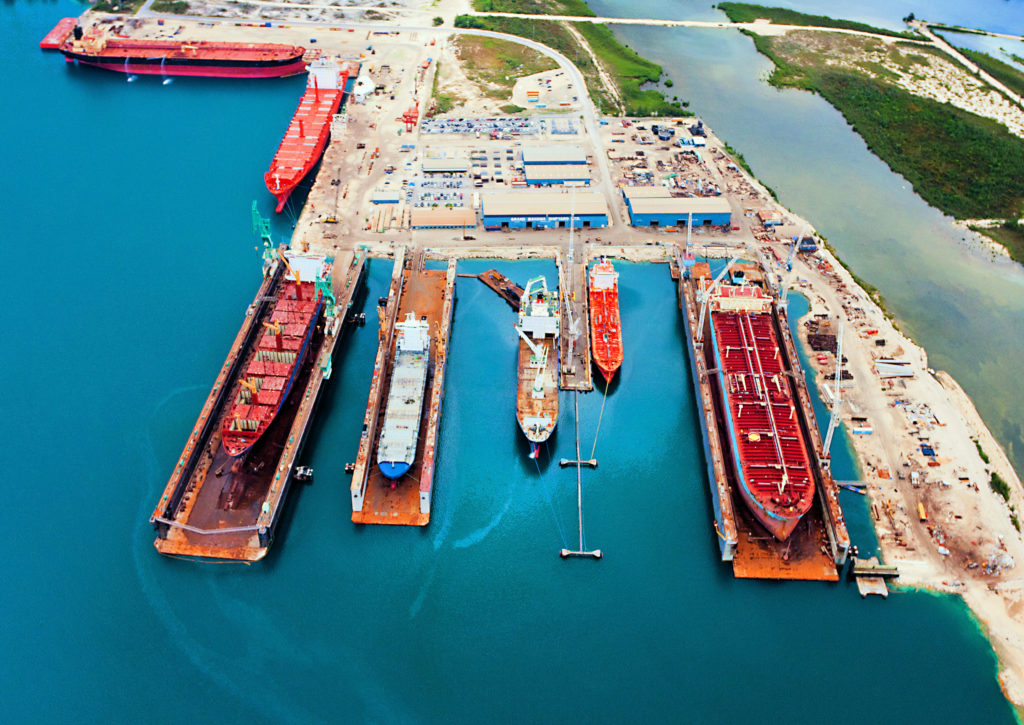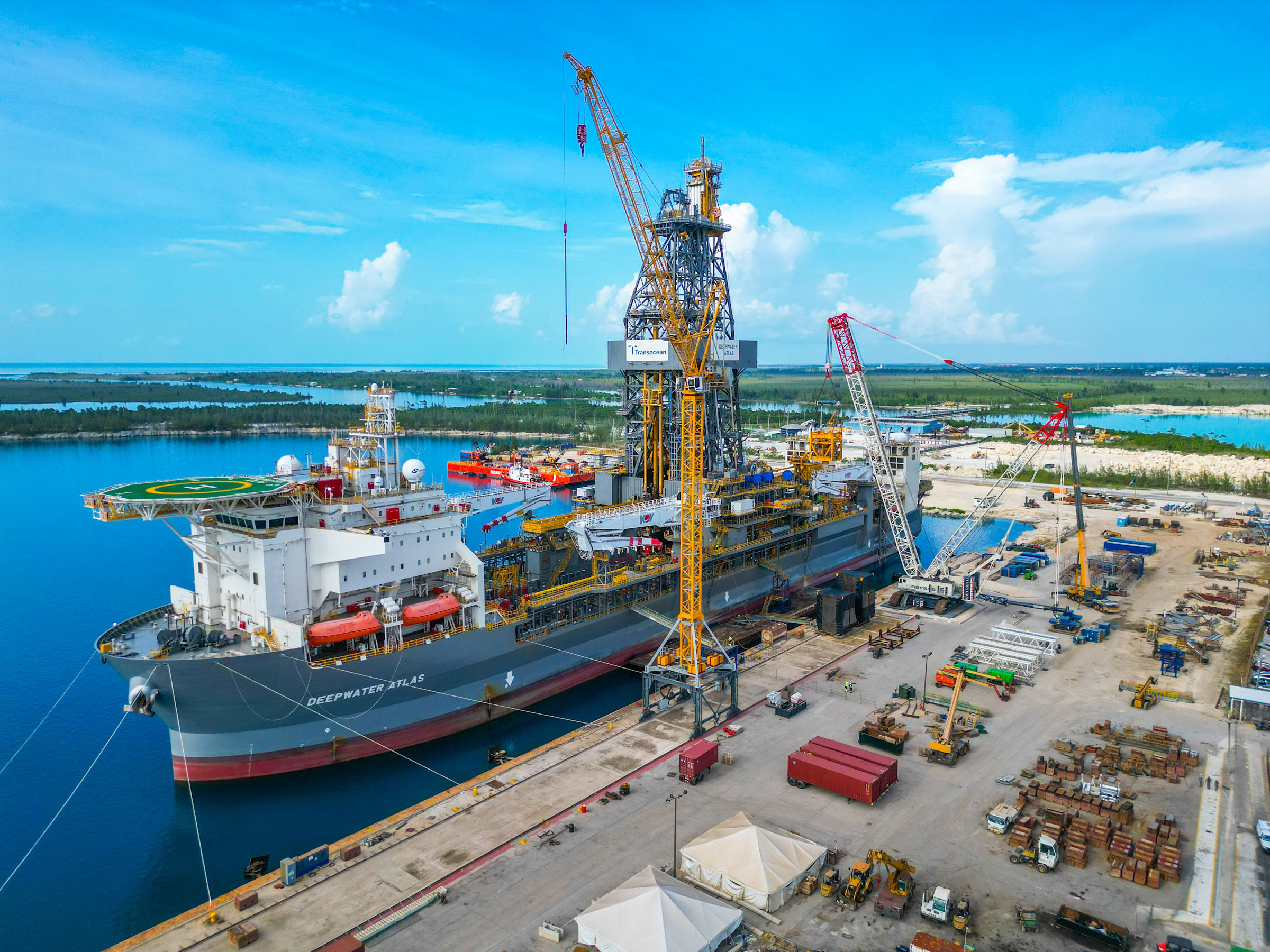Face the Facts with Dave Skentelbery, CEO of Grand Bahama Shipyard
An extremely resourceful business
Despite a roller-coaster ride of natural disasters and a pandemic, Grand Bahama Shipyard is very much alive and thriving.

Deepwater Atlas alongside at GBS
Dave Skentelbery initially joined the Grand Bahama Shipyard in January 2016 as VP of Commercial, and was promoted to CEO in 2017.

Dave Skentelbery, CEO of Grand Bahama Shipyard
Q. You have been CEO at GBS for about two years (seven years) now, so how does it compare with your previous jobs?
A.2 Grand Bahama Shipyard is certainly the busiest and most challenging ship repair yard I have worked in. We are probably the world’s busiest cruise ship yard, and that means we must be able to cope with multiple large projects in short time frames, and there is no room for delay. Many of the ships that leave here sail overnight to Florida and pick up passengers the day after leaving the yard. We must balance this with ensuring our customers from other industry sectors are served in a timely manner. There are of course challenges because we are located on a relatively small Island, so ensuring that everything is here and waiting for the vessel’s arrival is an important part of planning. The vast majority of our ship repair materials have to be imported and therefore planning and scheduling is important. We do however have excellent trade links by sea and air with the rest of the world. In terms of managing shipyards, it is the best business I have had the opportunity to run, and has certainly proved the adage; ‘you are never too old to learn’ and hopefully to add value to an already successful business.
A.7 This has been a job like no other! It is explained in more detail later in the article. It has been a roller-coaster ride of natural disasters and a pandemic, yet we have kept the business very much alive and thriving.
Q. What changes have you seen since you took over?
A.2 Since taking over we have seen a growth in revenue from both the cruise and commercial sector. Our ability to turn all types of vessels round in time frames that are generally shorter than our competitors is attractive to many owners and does give us a competitive edge. The cruise lines are giving us larger scopes of work that has allowed us to grow our revenues from this sector. Also, the cruise lines are becoming far more cost conscious than when I first arrived here, which is driving us to be more efficient and lowering our cost base. This will make us more attractive to all sectors.
A.7 We went from being the world’s busiest cruise repair shipyard, operating three docks, to a one-dock operation. The reasons behind this are complex; we lost a dock in an accident in April 2019 and then the island was struck by the Category 5 hurricane Dorian in September of the same year, causing major damage to the smallest of our docks. As we dusted ourselves off from these two major events Covid struck and brought the cruise industry to a standstill. Interestingly however we kept going; the demand for the one operational dock was high and the business thrived. We are now embarking on a $500m-plus transformation project that will see us getting two new floating docks. The biggest of these will be capable of lifting vessels of up to 130,000t displacement – for the cruise ship buffs amongst the readers, that is an Icon class vessel. We fully expect to regain our position as the world’s busiest cruise repair facility but have the capability to drive up revenues from commercial vessels.

We went from being The world’s busiest cruise repair shipyard went from operating three docks (seen here), to a one-dock operation.
Q. GBS has been through a period of expansion with investments in facility upgrades and purchasing of new machinery and tooling. Has this now been completed, or are there any further plans?
A.2 By no means is our investment complete, as we are continually reviewing and updating our facilities. In the coming year, we intend to add two more quayside cranes and commence upgrading our machine and pipe shop. This will benefit all the sectors in which we work. We are also increasing our warehouse space, which is important for our cruise customers when executing large revitalisation projects. Another area we are exploring is increasing our quay space, so we can get ships out of dock quicker and complete projects alongside. This will also allow us to develop our in-water survey capability.
A.7 These are extremely exciting times. The $500m transformation project is underway, the dock building at QBSIC China has started, dredging works for the new docks will start in March 2024, work has already started on the pier extensions and we are well advanced in a number of other areas to update the yard. We will receive and commission our first new dock by January 2026 and the second dock later in the same year. These new docks will be a game-changer in the region. We already have both cruise and other commercial vessels booked as far out as 2029.
Q. What does the market look like going ahead?
A.7 In the short term, whist we await the arrival of the new docks, the market looks strong with a mix of vessel types. Throughout 2020-2023 we have operated at 90%-plus dock occupancy plus a healthy amount of alongside repairs and in-water survey work. 2025 is already shaping up to be a good year, with an approximately 50/50 split between cruise and other vessels, and I expect dock occupancy again to be more than 90%. The cruise lines are different, post-Covid, being much more cost conscious, but booking levels are healthy. We have yet to see our first big revitalisation project post-Covid, but we cannot complain at the work we are getting.
Q. GBS has been looking to increase its share of repairs in other sectors. Has this been a success, and how much of the business accounts for work outside the cruiseship sector?
A.2 In short, yes this has been a success and continues to grow. The yard (despite industry myth) does not survive on cruise business alone, and vessels from other sectors are extremely important to us. Around 40% of our business comes from other sectors, and we are working towards increasing this. We have been successful in attracting and keeping customers, as they see value in our quality and ability to turn vessels around quickly and efficiently. We are also working on several facility development projects to enhance our efficiency and attractiveness to all other sectors.
A.7 Since 2020, our market split has moved dramatically and is now predominantly vessels other than cruise. This is great news for the business as we find we have many repeat customers and they come to us because of our timeliness, learned from the cruise projects, our pricing and quality. As we move forward there is going to be an inevitable increase in cruise revenues. However, with the new docks, we will be better able to have greater throughput and I think the vessel types we see will be more balanced. This will see us being a much more robust business, serving the marine market as a whole. Since 2020, GBS’s market split is now predominantly vessels other than cruise[/caption]
Q. What do you regard as your yard’s main (ship repair) strengths?
A.2 The ability to safely deliver vessels back to the owners on time, with a high level of quality, and where required, absorbing growth work into the original schedule. This, together with an experienced multi-national management team and workforce, allows us to be a leader in the cruise line repair industry, and an extremely credible, globally competitive repair yard for other sectors.
A.7 Nothing has changed since my last interview, other than we have demonstrated we have a resilience to overcome the worst of natural disasters and come out stronger and better than before. The ability to safely deliver vessels back to the owners on time, with a high level of quality and where required, absorbing extra work into the original schedule. This, together with an experienced multinational management team and workforce, allows us to be a leader in the cruise line repair industry and an extremely credible globally competitive repair yard for other sectors.
Q. Who do you regard as your main competitors and why?
A.2 + A.7 This varies depending on the vessel type and trading pattern. In the commercial sector we compete with the Mexican yards, Curaçao and Trinidad, and interestingly, Portugal for some vessels. Generally, this is on price, as rarely does a competing yard tender and meet a shorter timeframe. We see some competition from the US yards, but nothing too significant. In the cruise market, there is currently no regional competition. This does not make us complacent but vigilant and always looking at improving our offer to the cruise lines. Cruise lines do have options, particularly those that trade both in the Caribbean and Europe, so we must be able to compete with the European cruiseship repair yards.
Q. How do you see the future in terms of ship repair activity, both for your yard, and in more general terms for yards in the region?
A2. I believe we will see a steady growth in the commercial vessel sector, as we work on becoming more cost efficient. Certainly, we will see more demand for afloat work and in in-water surveys, as periods between dockings are extended. We are ideally suited for this with our deep-water berths (and I have to say the crystal-clear waters of the Bahamas), and it is certainly a market sector we intend to develop. Our location is perfect for this, with no great deviation required from the busy shipping routes, and we will apply the same principles of safe timely delivery to this service as we do to drydockings.
A.7 For us the future looks good, with bookings out till 2029 for approximately 40% of our planned revenue. Combined with a good regular customer base from across the marine world, I only see the yard going from strength to strength. We do compete with other yards in the region but as long as we maintain our competitive edge of safety, quality, timeliness and price we will thrive. I should add our location with regard to world shipping routes is also a great advantage.
Q. Is there anything you would like to add?
A2. There are some industry myths surrounding the yard regarding it being a cruise ship only yard; last year we docked 18 cruise vessels and 70 + vessels from other sectors. These included tankers, bulk carriers, offshore vessels, bulk carriers, containers ships, tugs and barges. Probably the only sector we did not engage was the defence sector. We are an extremely resourceful business, with an enviable track record and a mission to build on this for the future.
A.7 I believe we have broken the industry myth that we are a cruiseship-only yard. We have challenges to attract old customers back as the new docks come online, but that order book that I look at tells me we are already some way to resolving that. We cannot, however, be complacent and we will continue to focus on being a safe, efficient, value for money ship repair yard.
Read more articles like this in the latest issue of DryDock magazine

GBS in no longer just a cruiseship-only yard





